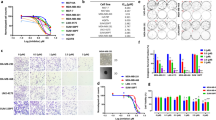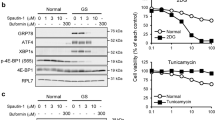Abstract
HAMLET is the first member of a new family of tumoricidal protein–lipid complexes that kill cancer cells broadly, while sparing healthy, differentiated cells. Many and diverse tumor cell types are sensitive to the lethal effect, suggesting that HAMLET identifies and activates conserved death pathways in cancer cells. Here, we investigated the molecular basis for the difference in sensitivity between cancer cells and healthy cells. Using a combination of small-hairpin RNA (shRNA) inhibition, proteomic and metabolomic technology, we identified the c-Myc oncogene as one essential determinant of HAMLET sensitivity. Increased c-Myc expression levels promoted sensitivity to HAMLET and shRNA knockdown of c-Myc suppressed the lethal response, suggesting that oncogenic transformation with c-Myc creates a HAMLET-sensitive phenotype. Furthermore, HAMLET sensitivity was modified by the glycolytic state of tumor cells. Glucose deprivation sensitized tumor cells to HAMLET-induced cell death and in the shRNA screen, hexokinase 1 (HK1), 6-phosphofructo-2-kinase/fructose-2,6-biphosphatase 1 and hypoxia-inducible factor 1α modified HAMLET sensitivity. HK1 was shown to bind HAMLET in a protein array containing ∼8000 targets, and HK activity decreased within 15 min of HAMLET treatment, before morphological signs of tumor cell death. In parallel, HAMLET triggered rapid metabolic paralysis in carcinoma cells. Tumor cells were also shown to contain large amounts of oleic acid and its derivatives already after 15 min. The results identify HAMLET as a novel anti-cancer agent that kills tumor cells by exploiting unifying features of cancer cells such as oncogene addiction or the Warburg effect.
This is a preview of subscription content, access via your institution
Access options
Subscribe to this journal
Receive 50 print issues and online access
$259.00 per year
only $5.18 per issue
Buy this article
- Purchase on Springer Link
- Instant access to full article PDF
Prices may be subject to local taxes which are calculated during checkout







Similar content being viewed by others
References
Abu-Hamad S, Zaid H, Israelson A, Nahon E, Shoshan-Barmatz V . (2008). Hexokinase-I protection against apoptotic cell death is mediated via interaction with the voltage-dependent anion channel-1: mapping the site of binding. J Biol Chem 283: 13482–13490.
Balendiran GK, Dabur R, Fraser D . (2004). The role of glutathione in cancer. Cell Biochem Funct 22: 343–352.
Baran R, Reindl W, Northen TR . (2009). Mass spectrometry based metabolomics and enzymatic assays for functional genomics. Curr Opin Microbiol 12: 547–552.
Brest P, Gustafsson M, Mossberg AK, Gustafsson L, Duringer C, Hamiche A et al. (2007). Histone deacetylase inhibitors promote the tumoricidal effect of HAMLET. Cancer Res 67: 11327–11334.
Brummelkamp TR, Bernards R . (2003). New tools for functional mammalian cancer genetics. Nat Rev Cancer 3: 781–789.
Christofk HR, Vander Heiden MG, Harris MH, Ramanathan A, Gerszten RE, Wei R et al. (2008). The M2 splice isoform of pyruvate kinase is important for cancer metabolism and tumour growth. Nature 452: 230–233.
Coleman MC, Asbury CR, Daniels D, Du J, Aykin-Burns N, Smith BJ et al. (2008). 2-Deoxy-D-glucose causes cytotoxicity, oxidative stress, and radiosensitization in pancreatic cancer. Free Radic Biol Med 44: 322–331.
Dang CV . (1999). c-Myc target genes involved in cell growth, apoptosis, and metabolism. Mol Cell Biol 19: 1–11.
Dang CV, Kim JW, Gao P, Yustein J . (2008). The interplay between MYC and HIF in cancer. Nat Rev Cancer 8: 51–56.
Dang CV, Le A, Gao P . (2009). MYC-induced cancer cell energy metabolism and therapeutic opportunities. Clin Cancer Res 15: 6479–6483.
Denko NC . (2008). Hypoxia, HIF1 and glucose metabolism in the solid tumour. Nat Rev Cancer 8: 705–713.
Duringer C, Hamiche A, Gustafsson L, Kimura H, Svanborg C . (2003). HAMLET interacts with histones and chromatin in tumor cell nuclei. J Biol Chem 278: 42131–42135.
Evan GI, Wyllie AH, Gilbert CS, Littlewood TD, Land H, Brooks M et al. (1992). Induction of apoptosis in fibroblasts by c-myc protein. Cell 69: 119–128.
Felsher DW, Bishop JM . (1999). Reversible tumorigenesis by MYC in hematopoietic lineages. Mol Cell 4: 199–207.
Fiehn O, Wohlgemuth G, Scholz M . (2005). Setup and annotation of metabolomic experiments by integrating biological and mass spectrometric metadata. Lect Notes Comput Sci 3615: 224–239.
Fischer W, Gustafsson L, Mossberg AK, Gronli J, Mork S, Bjerkvig R et al. (2004). Human alpha-lactalbumin made lethal to tumor cells (HAMLET) kills human glioblastoma cells in brain xenografts by an apoptosis-like mechanism and prolongs survival. Cancer Res 64: 2105–2112.
Gustafsson L, Leijonhufvud I, Aronsson A, Mossberg AK, Svanborg C . (2004). Treatment of skin papillomas with topical alpha-lactalbumin-oleic acid. N Engl J Med 350: 2663–2672.
Hakansson A, Zhivotovsky B, Orrenius S, Sabharwal H, Svanborg C . (1995). Apoptosis induced by a human milk protein. Proc Natl Acad Sci USA 92: 8064–8068.
Hanahan D, Weinberg RA . (2000). The hallmarks of cancer. Cell 100: 57–70.
Hanahan D, Weinberg RA . (2011). Hallmarks of cancer: the next generation. Cell 144: 646–674.
Hernlund E, Ihrlund LS, Khan O, Ates YO, Linder S, Panaretakis T et al. (2008). Potentiation of chemotherapeutic drugs by energy metabolism inhibitors 2-deoxyglucose and etomoxir. Int J Cancer 123: 476–483.
Hsu PP, Sabatini DM . (2008). Cancer cell metabolism: Warburg and beyond. Cell 134: 703–707.
Ihrlund LS, Hernlund E, Khan O, Shoshan MC . (2008). 3-Bromopyruvate as inhibitor of tumour cell energy metabolism and chemopotentiator of platinum drugs. Mol Oncol 2: 94–101.
Kim JW, Tchernyshyov I, Semenza GL, Dang CV . (2006). HIF-1-mediated expression of pyruvate dehydrogenase kinase: a metabolic switch required for cellular adaptation to hypoxia. Cell Metab 3: 177–185.
Ko YH, Smith BL, Wang Y, Pomper MG, Rini DA, Torbenson MS et al. (2004). Advanced cancers: eradication in all cases using 3-bromopyruvate therapy to deplete ATP. Biochem Biophys Res Commun 324: 269–275.
Kroemer G, Pouyssegur J . (2008). Tumor cell metabolism: cancer's Achilles' heel. Cancer Cell 13: 472–482.
Li Y, Holland CA, Hartley JW, Hopkins N . (1984). Viral integration near c-myc in 10–20% of mcf 247-induced AKR lymphomas. Proc Natl Acad Sci USA 81: 6808–6811.
Mathupala SP, Rempel A, Pedersen PL . (1997). Aberrant glycolytic metabolism of cancer cells: a remarkable coordination of genetic, transcriptional, post-translational, and mutational events that lead to a critical role for type II hexokinase. J Bioenerg Biomembr 29: 339–343.
Mazurek S, Boschek CB, Hugo F, Eigenbrodt E . (2005). Pyruvate kinase type M2 and its role in tumor growth and spreading. Semin Cancer Biol 15: 300–308.
Mossberg AK, Hou Y, Svensson M, Holmqvist B, Svanborg C . (2010). HAMLET treatment delays bladder cancer development. J Urol 183: 1590–1597.
Mossberg AK, Wullt B, Gustafsson L, Mansson W, Ljunggren E, Svanborg C . (2007). Bladder cancers respond to intravesical instillation of HAMLET (human alpha-lactalbumin made lethal to tumor cells). Int J Cancer 121: 1352–1359.
Nilsson JA, Cleveland JL . (2003). Myc pathways provoking cell suicide and cancer. Oncogene 22: 9007–9021.
Papandreou I, Cairns RA, Fontana L, Lim AL, Denko NC . (2006). HIF-1 mediates adaptation to hypoxia by actively downregulating mitochondrial oxygen consumption. Cell Metab 3: 187–197.
Pelengaris S, Khan M, Evan GI . (2002). Suppression of Myc-induced apoptosis in beta cells exposes multiple oncogenic properties of Myc and triggers carcinogenic progression. Cell 109: 321–334.
Satoh J, Nanri Y, Yamamura T . (2006). Rapid identification of 14-3-3-binding proteins by protein microarray analysis. J Neurosci Methods 152: 278–288.
Scholz M, Fiehn O . (2007). SetupX—a public study design database for metabolomic projects. Pac Symp Biocomput, 169–180.
Shim H, Dolde C, Lewis BC, Wu CS, Dang G, Jungmann RA et al. (1997). c-Myc transactivation of LDH-A: implications for tumor metabolism and growth. Proc Natl Acad Sci USA 94: 6658–6663.
Silva JM, Li MZ, Chang K, Ge W, Golding MC, Rickles RJ et al. (2005). Second-generation shRNA libraries covering the mouse and human genomes. Nat Genet 37: 1281–1288.
Silva JM, Marran K, Parker JS, Silva J, Golding M, Schlabach MR et al. (2008). Profiling essential genes in human mammary cells by multiplex RNAi screening. Science 319: 617–620.
Smyth GK, Speed T . (2003). Normalization of cDNA microarray data. Methods 31: 265–273.
Soucek L, Whitfield J, Martins CP, Finch AJ, Murphy DJ, Sodir NM et al. (2008). Modelling Myc inhibition as a cancer therapy. Nature 455: 679–683.
Svanborg C, Agerstam H, Aronson A, Bjerkvig R, Duringer C, Fischer W et al. (2003). HAMLET kills tumor cells by an apoptosis-like mechanism—cellular, molecular, and therapeutic aspects. Adv Cancer Res 88: 1–29.
Svensson M, Hakansson A, Mossberg AK, Linse S, Svanborg C . (2000). Conversion of alpha-lactalbumin to a protein inducing apoptosis. Proc Natl Acad Sci USA 97: 4221–4226.
Thomas DB, Lingwood CA . (1975). A model of cell cycle control: effects of thymidine on synchronous cell cultures. Cell 5: 37–42.
Vander Heiden MG, Cantley LC, Thompson CB . (2009). Understanding the Warburg effect: the metabolic requirements of cell proliferation. Science 324: 1029–1033.
Warburg O . (1956). On the origin of cancer cells. Science 123: 309–314.
Watson PH, Pon RT, Shiu RP . (1991). Inhibition of c-myc expression by phosphorothioate antisense oligonucleotide identifies a critical role for c-myc in the growth of human breast cancer. Cancer Res 51: 3996–4000.
Weinstein IB, Joe A . (2008). Oncogene addiction. Cancer Res 68: 3077–3080; discussion 3080.
Wilson JE . (2003). Isozymes of mammalian hexokinase: structure, subcellular localization and metabolic function. J Exp Biol 206: 2049–2057.
Yalcin A, Telang S, Clem B, Chesney J . (2009). Regulation of glucose metabolism by 6-phosphofructo-2-kinase/fructose-2,6-bisphosphatases in cancer. Exp Mol Pathol 86: 174–179.
Zender L, Xue W, Zuber J, Semighini CP, Krasnitz A, Ma B et al. (2008). An oncogenomics-based in vivo RNAi screen identifies tumor suppressors in liver cancer. Cell 135: 852–864.
Zhang H, Gao P, Fukuda R, Kumar G, Krishnamachary B, Zeller KI et al. (2007). HIF-1 inhibits mitochondrial biogenesis and cellular respiration in VHL-deficient renal cell carcinoma by repression of C-MYC activity. Cancer Cell 11: 407–420.
Acknowledgements
This study was supported by the Sharon D Lund foundation grant and the American Cancer Society, the Swedish Cancer Society, the Swedish Medical Research Council, the Medical Faculty (Lund University), the Söderberg Foundation, the Anna-Lisa and Sven-Erik Lundgren Foundation for Medical Research, the Knut and Alice Wallenberg Foundation, the Lund City Jubileumsfond, the John and Augusta Persson Foundation for Medical Research, the Maggie Stephens Foundation, the Gunnar Nilsson Cancer Foundation, the Inga-Britt and Arne Lundberg Foundation, the HJ Forssman Foundation for Medical Research, the Royal Physiographic Society, the Swedish Society for Medical Research, the Network of Excellence: EuroPathoGenomics, the Crafoord Foundation, the Österlund Foundation, the US Department of Energy Low Dose SFA Program at Berkeley Lab [DE-AC02-05CH11231], the National Institutes of Health, National Cancer Institute grant U54 CA 112970 and the California Breast Cancer Research Program [15IB-0063].
Author information
Authors and Affiliations
Corresponding author
Ethics declarations
Competing interests
The authors declare no conflict of interest. There is at present no commercial development of HAMLET as a therapeutic agent in which the authors are involved.
Additional information
Supplementary Information accompanies the paper on the Oncogene website
Rights and permissions
About this article
Cite this article
Storm, P., Aits, S., Puthia, M. et al. Conserved features of cancer cells define their sensitivity to HAMLET-induced death; c-Myc and glycolysis. Oncogene 30, 4765–4779 (2011). https://doi.org/10.1038/onc.2011.196
Received:
Revised:
Accepted:
Published:
Issue Date:
DOI: https://doi.org/10.1038/onc.2011.196
Keywords
This article is cited by
-
BAMLET administration via drinking water inhibits intestinal tumor development and promotes long-term health
Scientific Reports (2024)
-
Gold/alpha-lactalbumin nanoprobes for the imaging and treatment of breast cancer
Nature Biomedical Engineering (2020)
-
The Use of Human, Bovine, and Camel Milk Albumins in Anticancer Complexes with Oleic Acid
The Protein Journal (2018)
-
Targeting of nucleotide-binding proteins by HAMLET—a conserved tumor cell death mechanism
Oncogene (2016)
-
Unraveling heterogeneous susceptibility and the evolution of breast cancer using a systems biology approach
Genome Biology (2015)



